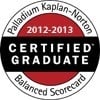Ever felt lost in a sea of SAP data, wondering how to make sense of it all? Many finance executives find themselves grappling with turning raw numbers into actionable plans. This can feel even harder when developing a proper reporting strategy.
You need to get reporting strategy insights, and that is our topic today. It's a common challenge, and coming up with methods that work requires a nuanced approach. Let's discuss transforming your reporting from a task into a tool for success with a valid reporting strategy.
Building the Foundation for Strategic Reporting
Before any deep analysis, it's critical to define where you stand. This begins with a clear understanding of your current corporate strategy. A well-defined strategy provides answers that help build insights aligned with long-term goals.
This is something I learned and used with every SAP implementation. The principle remains consistent. Define the current business strategy around these questions:
- Where do we compete?
- What value do we offer?
- How do we create that value?
- What lets us keep that advantage?
This may seem basic. But getting company leaders to agree on these four simple, yet key, questions may not be as clear as one might think.
Why This Matters - A Real-World Scenario
Consider a past client, a large manufacturing firm. They believed their brand strength was their main advantage.
After examining customer purchase drivers through data, it turned out their pricing was attracting most customers. That one discovery changed everything.
Managers could miss a core concept and make major mistakes if reporting lacks depth. Clear business process requirements around reporting are extremely important for making strides in getting more from reporting strategy insights and using reporting strategy for a long-term impact.
Highlighting the Insights from Reporting Data
The description helps you highlight your reporting strategy insights more clearly. View these findings in light of clear strategic objectives, instead of isolated pieces.
Here's a simple but powerful approach inspired by a Harvard Business Review technique. It is easy for business people to understand.
| Area of Analysis | Key Insight Example | Impact |
|---|---|---|
| External Analysis (PEST) | Consumers are moving fast to electric vehicles (EV). | Major shift in product demand. |
| Industry Analysis | Buyer power is growing for commodities. | Makes it harder to stay profitable. |
| Internal Capabilities | We don't have electric product offerings for consumers. | Can we adapt to growing markets, such as with electrical offerings? |
Remember to keep a lot of your details beneath the surface. Using simple tools, such as Excel reporting templates, helps.
Focus on key conclusions in discussions. Strategic reporting is critical for success.
Connecting Analysis to Business Action
Consider an example: shifting customer preference toward 'green' products (an external insight). If your internal assessment shows your firm lacks this, that gap tells a critical story.
It might show a need to invest in new materials or skills. The analysis helps answer why things matter and what you do about it.
This goes beyond just reporting figures. The concept of a 360-degree view can help inform strategic decisions.
Mapping Out Actionable Reporting Recommendations
Good reporting strategy insights lead to recommendations. Use this for increased revenue streams.
Let’s discuss recommendations from strategy-focused reporting insights. Keep it relevant, simple, and logical:
- Based on External/Internal Findings
- Say you found demand shifts (external), yet your resources don’t fully align.
- Possible recommendation: Invest in areas matching changes.
- Weigh Risks and Benefits
- Being first-to-market can help.
- You could also recommend catching up to leaders.
- For example, a product strategy that positions you slightly behind early players in product cycles.
- Connect Back to Strategy Basics
- Perhaps existing segments have diminishing returns.
- Recommending you leave existing customer groups might flow.
- However, this depends on if your customers buy based on price.
ROI and Strategy Measurement
As an expert in Managerial Accounting, measuring ROI correctly is foundational. I constantly ask my SAP project team: Does a focus only on profits match broader aims?
You may want to also use the following measures. Profitability measures the end result, especially in publicly traded companies.
It consists of two key parts: Margin measures & Turnover. Let's dive into each:
- Margin measures focus on what's left of each sale after costs.
- Turnover is how fast inventory, production, and payment cycles are.
Margin X Turnover = Profitability. Profitability/Assets used to get it = ROI.
Strategically, this helps answer core questions. Should we change price approaches?
Do we push volume over margins, or vice-versa? What is an accepted return level? Measuring profitability alone gives an incomplete assessment. Expand beyond that marker when tracking ROI to gain better insights.
Integrating Reporting with SAP Tools
Leveraging SAP fully gets data needed for improvement, and a great reporting strategy helps. Connecting reporting modules brings added value.
In a merger project, we found using SAP CO (Controlling) correctly helped greatly. It allowed us to get fair transfer prices in cross-company agreements.
We connected CO with the SAP SEM suite (Strategic Enterprise Management). This created views tracking strategic aims, including return tracking, and ultimately helped improve Key Performance Indicators.
This improved internal accountability. This alignment can feel like the hardest part, linking high strategy with everyday systems.
Doing this increases business agility across levels using SAP properly. Strategic reporting can get everyone on the same page.
Data Quality and Trust
Good analysis is useless without solid data quality. During an early BW (Business Warehouse) implementation, reports contradicted executive experience.
Quick testing proved data problems. It loaded incomplete due to a bad process.
Cleaning this upfront builds trust. Involve cross-functional teams during early process development, since you want support from team leads.
Advanced Analytical Insights and the Future
As technologies evolve, reporting must too. Exploring predictive models becomes necessary beyond simple reports.
Tools using artificial intelligence can identify risks and opportunities. Consider options like Deloitte Analytics, which specializes in AI and advanced analysis.
These improve analysis overall. Use advanced tools to make even better decisions in the future.
FAQs about Reporting Strategy Insights
What are reporting insights?
Reporting insights go beyond surface-level data. They transform raw information into meaningful, actionable conclusions.
Insights explain not just "what" happened, but also "why". This provides a clear path for strategy adjustments and informed decision-making.
How do you define a reporting strategy?
A reporting strategy is a plan that outlines how an organization collects, processes, analyzes, and communicates data. It supports decision-making.
It specifies the types of reports, frequency, data sources, audience, and analytical methods. These are needed to turn information into effective actions.
What are insights in strategy?
In strategy, insights refer to the understanding of business drivers, market trends, and internal capabilities. These come from a strong analysis of data.
These insights reveal connections and recommendations that guide decisions. They influence a company's direction and resource allocation.
What are four strategies for getting to insights?
To gain insights, companies use the 4 D's: describing current strategies, diagnosing why strategies work or fail, developing new strategies based on data, and deploying them with measurable outcomes. These steps ensure alignment between data analysis and decision-making.
Conclusion
Getting useful Reporting Strategy Insights relies on combining SAP system understanding with strategic focus. Insights are just the starting point.
Translating those into action makes all the difference. Ultimately, your reporting should explain the "what" and help explore the "why."
This is how you gain a real competitive edge. Effective reporting allows a business to quickly adapt and thrive.
We are a full-service Strategy Development Consultancy. We leverage the Balanced Scorecard to help our clients achieve superior returns. Please our book a meeting service to get started.



